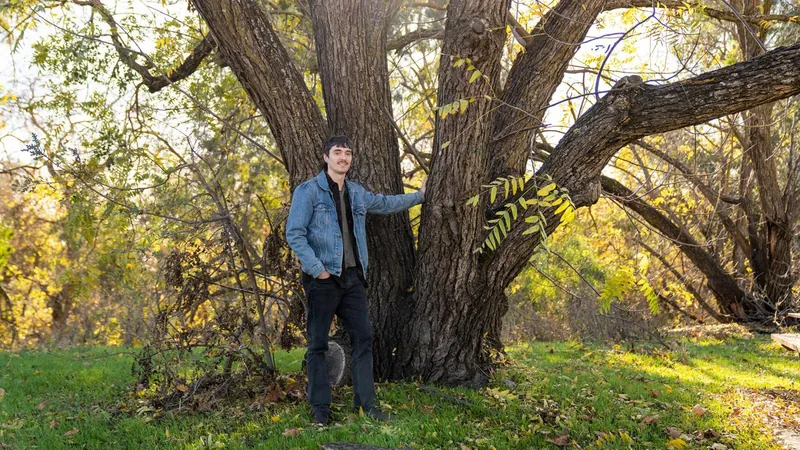
Unlocking the Secret of Walnut Trees: The Genetics Behind Their Mysterious Sex Patterns!
2025-01-06
Author: Jacob
Groundbreaking Study by UC Davis Biologists
In a groundbreaking study, biologists from the University of California, Davis, have unveiled the genetic mechanisms behind the fascinating alternating sexes of walnut trees, shedding light on a biological phenomenon that has puzzled researchers for centuries. This pivotal research, published in the esteemed journal *Science* on January 3, reveals that the underlying mechanisms have remained stable in walnuts and their ancestors for an astonishing 40 million years. What's even more intriguing is the unexpected parallels this system shares with sex determination in humans and various animal species!
The Distinct Reproductive Strategy of Walnut Trees
Many flowering plants have evolved intricate strategies to avoid self-pollination, utilizing methods such as specialized flower structures and the development of separate male and female plants. However, walnut trees take this remarkable adaptation a step further. These trees can produce flowers of one sex and then the other within the same season—though distinct trees will consistently flower either male-first or female-first. This captivating phenomenon, noted as early as 1877 by the eminent Charles Darwin, intrigued scientists for decades.
Insights from UC Davis Research Team
According to Jeff Groh, a graduate student in population biology and the lead author of the study, "Walnuts and pecans exhibit a temporal dimorphism by alternating between male and female flowering throughout the season. Despite being known since the 1800s, this phenomenon has never been fully understood at a molecular level—until now."
Research Methodology and Findings
The research team explored both domesticated walnut varieties and their wild counterparts, such as the Northern California black walnut, discovering that the ratio of male-first to female-first trees in the wild hovers around 1:1.
Using data from UC Davis' walnut breeding program, Groh and his doctoral advisor, Professor Graham Coop, meticulously documented the flowering patterns of Northern California black walnut trees around the campus. By classifying these trees into male-first or female-first groups, they sequenced their genomes and identified specific genetic sequences associated with these flowering traits.
What they found was astonishing: two variants of a gene linked directly to female-first and male-first flowering types, a genetic polymorphism that has persisted across at least nine walnut species for nearly 40 million years. "It's quite rare to see such sustained variation over such an extended period," Groh noted. The intricate balance between these two flowering types serves to maintain genetic diversity; when one type becomes dominant, the opposite type gains a mating advantage, ensuring a continuous push towards equilibrium.
Connections to Pecans and Evolutionary Insights
Further research revealed that pecans, closely related to walnuts, also possess a balanced genetic polymorphism influencing flowering order, albeit linked to a different region of the genome. Notably, pecan flowering polymorphism appears even older—over 50 million years—compared to their walnut counterparts.
But how did walnuts and pecans, despite their close genetic relationship, end up with similar flowering mechanisms governed by distinct genes? Scientists speculate that their shared ancestors may have independently evolved similar solutions to reproductive challenges. Alternatively, this dual flowering system may have originated as far back as 70 million years ago, with the genetic pathways changing over time.
Broader Implications for Understanding Sex Determination
Intriguingly, this genetic interplay bears resemblance to animal sex chromosomes, such as the X and Y chromosomes in mammals, which also maintain an equilibrium between two structural variants.
"There’s a compelling parallel to a common mode of sex determination," stated Groh, highlighting the broader implications of this research not just for plants but for our understanding of sex differentiation across the tree of life.
Future Research Directions
This study not only provides significant insights into walnut genetics but also paves the way for future research into plant reproductive strategies and their evolutionary significance. As scientists continue to unravel the complexities of nature, who knows what other secrets lie waiting to be discovered in the fascinating world of genetics?









 Brasil (PT)
Brasil (PT)
 Canada (EN)
Canada (EN)
 Chile (ES)
Chile (ES)
 Česko (CS)
Česko (CS)
 대한민국 (KO)
대한민국 (KO)
 España (ES)
España (ES)
 France (FR)
France (FR)
 Hong Kong (EN)
Hong Kong (EN)
 Italia (IT)
Italia (IT)
 日本 (JA)
日本 (JA)
 Magyarország (HU)
Magyarország (HU)
 Norge (NO)
Norge (NO)
 Polska (PL)
Polska (PL)
 Schweiz (DE)
Schweiz (DE)
 Singapore (EN)
Singapore (EN)
 Sverige (SV)
Sverige (SV)
 Suomi (FI)
Suomi (FI)
 Türkiye (TR)
Türkiye (TR)
 الإمارات العربية المتحدة (AR)
الإمارات العربية المتحدة (AR)